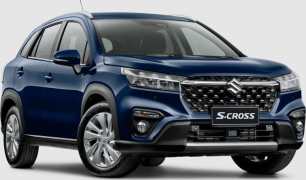The previous-generation X2 always felt a bit more Audi or Volkswagen than BMW in the way it went down a road.
This latest iteration has a secure, dynamic balance more in-keeping with the blue-and-white roundel and is far more impressive than its predecessor.
We spent our first leg in the performance-oriented M35i. The punchy engine, front-biased AWD and slick transmission felt just right in the sporty small SUV.
It sits 15mm lower than the other variants on differently tuned springs and adaptive dampers.
The M35i holds onto the tarmac like a limpet with minimal body roll at very high limits partly thanks to the efficiency-oriented 245/35R21 Continental Eco Contact 6 Q tyres.
Yet this comes at the cost of adjustability. With such tight rebound damping in Sport and Sport Plus modes, the M35i's body is too tied down. Even in Comfort, the M35i hopped and fidgeted over Tasmania's broken tarmac, a trait not aided by the 21-inch alloys.
We would have preferred more build-up in the steering weight, too, given the sporting intentions. That chubby wheel rim does its best to remove any sensation of feedback, too.
BMW's iDrive is mostly fantastic except when it comes to changing drive modes, which you need to do fairly regularly in the M35i.
More than just normal – or Personal here – there's configurable Sport and Efficiency modes. There's also Digital Art and other less useful options.
Thankfully, the xDrive20 is much sweeter. Even optioned up with the 20-inch alloy wheels the ride is a lot more agreeable and well-suited to Tasmania's lumpy roads.
All the damper modes were usable with Sport providing welcome extra support without being too strict. Turning into corners felt more natural in the xDrive20 thanks to a bit more body roll which helps communicate grip levels.
The xDrive20i did feel low on grunt after the M35i and iX2 xDrive30 but that was only in a direct comparison - grunt levels were plenty once accustomed. We did miss the M35i's front limited-slip differential on loose surfaces, but it wasn't a deal breaker.
Seeing that the iX2 xDrive30's kerb weight was 325kg higher than the M35i (2020kg) set alarm bells going initially. That's a lot of extra weight for a 'small SUV' to be carrying around, and is beyond a Tesla Model Y Long Range (1979kg).
The iX2 uses the same kinematics and suspension components as the petrol cars but in completely retuned states. Encouragingly, the result is rather excellent.
You do notices the weight when pushing through patchily surfaced corners. The iX2 bobbles and hops occasionally as you approach the damper's limits, but to their credit they never gave up.
That light steering – which is frustrating in the M35i – aids to disguise the xDrive30's extra mass, too. As all X2's are front-biased AWD models, they never quite reach the dynamic heights of BMW's Cluster Architecture models.
Still, grunt is prodigious and, although it's officially slower than the M35i, the xDrive30's rolling response is predictably excellent. BMW has done a great job calibrating the regenerative braking, too.
I found Moderate was my preference, and because the brake pedal blends caliper and regenerative forces you lose precious little range from not having it jacked all the way up.
The iX2 is quiet inside, too. There's almost no wind intrusion and tyre roar is kept to a bare minimum inside, especially impressive given that the M35i sends quite some road noise into the cabin.
Returning through Hobart's outer suburbs, we notice some shortcomings. The iX2's high bonnet, low-set seating position and letterbox rear glass with protruding rear lip spoiler mean visibility is compromised. The X1 doesn't suffer from such issues.
That's the cost of visual flare and the excellent 360-degree camera and head-up display help to alleviate guesswork and keep eyes on the road.
The M35i didn't feel the most complete on the road. If you're chasing a sporty coupe statement at this kind of price, the BMW 230i coupe is a great driver's car.
Instead, you're better to spend money on either the xDrive20i or iX2 xDrive30 with some choice options and enjoy a slick coupe SUV driving experience.






















.png)







.png)


.png)

.png)

.png)


.png)

.png)

.png)
.png)
.png)



.png)


.png)





.png)













































.png)
.png)













.png)

























 copy.png)








.png)











.png)

.png)


.png)












.png)


.png)








